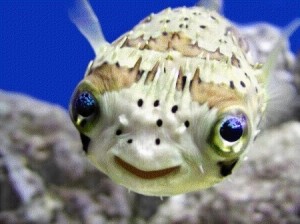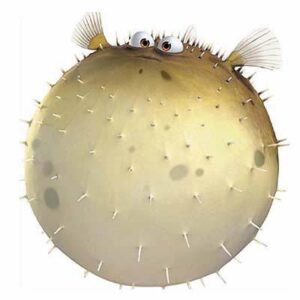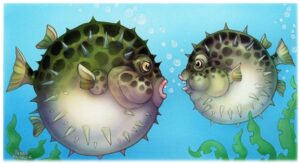Aside from showing up in spy movies as a source for a lethal poison culled from the ovaries of the female or the liver of either sex, puffer fish (or “blowfish”, or Tetraodontidae) aren’t talked about or seen all that often. They’re really cool little animals though. I mean, take a look:
 Seriously, kinda cute, right?
Seriously, kinda cute, right?
Big, doe-like eyes.
Little fluttery wing-like fins, almost like a hummingbird.
A mouth that almost always seems to be smiling. It’s a shame that people don’t know anything more about them than that you can chop them open, rip out their organs, grind ’em up into a powder and kill someone…or turn them into a zombie if you believe urban legends.
You don’t hear about them because they’re relatively docile creatures. It’s not like they go after people casually enjoying a swim like sharks. There’s never been an “Attack of the PUFFERFISH!!!!” cheesy B movie made about scantily clad sorority chicks getting skewered by a flushed fish that just didn’t make the grade at the local sushi joint looking for revenge on humanity…although as desperate as Hollywood seems to be, don’t be surprised if it happens.
So, here we have this creature that seems innocent, friendly and helpful…but then at the slightest sign of danger or even just perceived danger…
…it happens…and it’s just got to be a little embarrassing when it does, too…
 “DANGER!” [POOF]
“DANGER!” [POOF]
Blown up like a balloon.
All your friends point and laugh. All the other fish start calling you “fatty”, or chanting “airball”.
It’s not pretty.
It’s funny…but not pretty.
But…it’s also not their fault. Nature made them that way. However, studies have shown (proving yet again that scientists have too much free time and a lot of money goes towards a lot of stupid scientific grants) that they can learn to control the response. That, given time, they learn to distinguish between actual danger and a random ripple in the water that’s not really a voodoo doctor looking to score a new slave.
I know, I know…”Dave…you’re rambing again. What’s the point?” I have one, I swear.
Pufferfish are making a strong comeback in the wild lately…in office environments across America. Times are tough. Everyone’s nervous about their jobs…and the Tetraodontidae Coworkeris react a lot differently than they do when things are mellow. It might happen when you’re in a meeting with IT, making a casual comment about how something can be perhaps done a little differently…
“DANGER!” [POOF]
…and suddenly your ears are assaulted by a rambling diatribe liberally sprinkled with techno-babble in an attempt to bluster and confuse the perceived source of danger.
…or maybe you’re in a meeting with a different business team discussing a dependency that appears to be running a little behind schedule, and would it be possible to get an update on…
“DANGER!” [POOF]
…and now you’re stuck listening to personnel constraints that everyone knows aren’t really there.
Or…and the worst case scenario…you’re in a multi-department, cross-functional meeting discussing several issues that are impacting a large project’s schedule, and then…
“DANGER!” [POOF]
“DANGER!” [POOF]
 You’ve got multiples. It’s over. Whether you want it to be or not, your meeting’s done now, because nothing valuable is getting accomplished…
You’ve got multiples. It’s over. Whether you want it to be or not, your meeting’s done now, because nothing valuable is getting accomplished…
…unless you’re an otter.
Why an otter?
Otters are smart. They adapt quickly, and they like getting things done. They’re also immune to the natural toxins that the pufferfish produces. So when an otter encounters a pufferfish, the first thought is “snacktime!”. Now, the smart move here would be for the puffer to swim to safety – clear out, get some distance between it and the otter, and then go back to swimming and smiling and looking cute. Unfortunately for the puffer, natural instincts tend to take over and it’s “DANGER!” [POOF] time. Also unfortunately for the puffer, otters are extremely playful…and patient.
So now the puffer has basically turned itself into a ball to be toyed with by the otter. The otter plays for a while…tosses it around, makes it splash in the water, tosses it up in the air…until eventually one of two things happens:
1) The inexperienced otter has so much fun playing with the new ball that it forgets that it was originally hungry, and so eventually meanders off in search of something else to do.
2) The experienced otter gets bored playing and remembers that lunch is in that ball somewhere, and so the sharp teeth and claws come out, and it’s all over for the poor little puffer.
The moral of this story? There’s really no sense in being a nervous pufferfish these days. Learn to control your instincts and don’t over-react to perceived threats. In the best case…you wind up being a playtoy for a wily otter with everyone else in the neighborhood watching…in the worst case, you wind up as lunch. Just take a deep breath (but not deep enough to puff up!) and survey the situation closely. Find your escape route and take it, or, even better, look around and realize that it’s just some kelp that brushed up against your fin and not a predator after all.
And if you can’t learn to control it…well, look out for otters.

